SMA to N adapter: selection, sealing & ordering
Oct 11,2025
Identify the exact gender combo in seconds—what ends do you have?
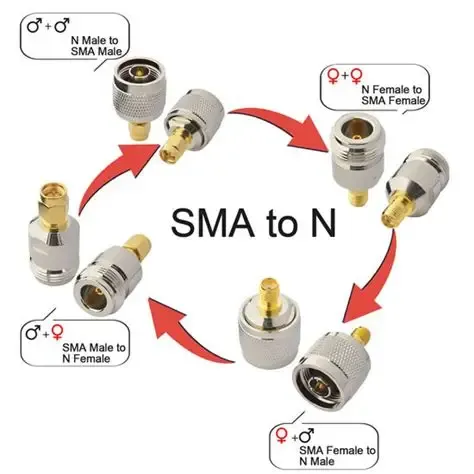
This figure appears at the beginning of the document, aiming to quickly show readers the main types of adapters they might encounter when interfacing SMA and N connectors (e.g., N Male to SMA Male, SMA to N Female). It establishes a basic visual understanding, setting the stage for the subsequent detailed discussion on the application scenarios of each combination and how to avoid selection errors.
Anyone who has worked in RF labs knows the headache of getting the wrong adapter. At first glance, SMA and N connectors look straightforward, but gendering them correctly causes more errors than most people would expect.
On the SMA side:
- SMA male → external threads with a projecting pin.
- SMA female → internal threads with a recessed socket.
On the N side:
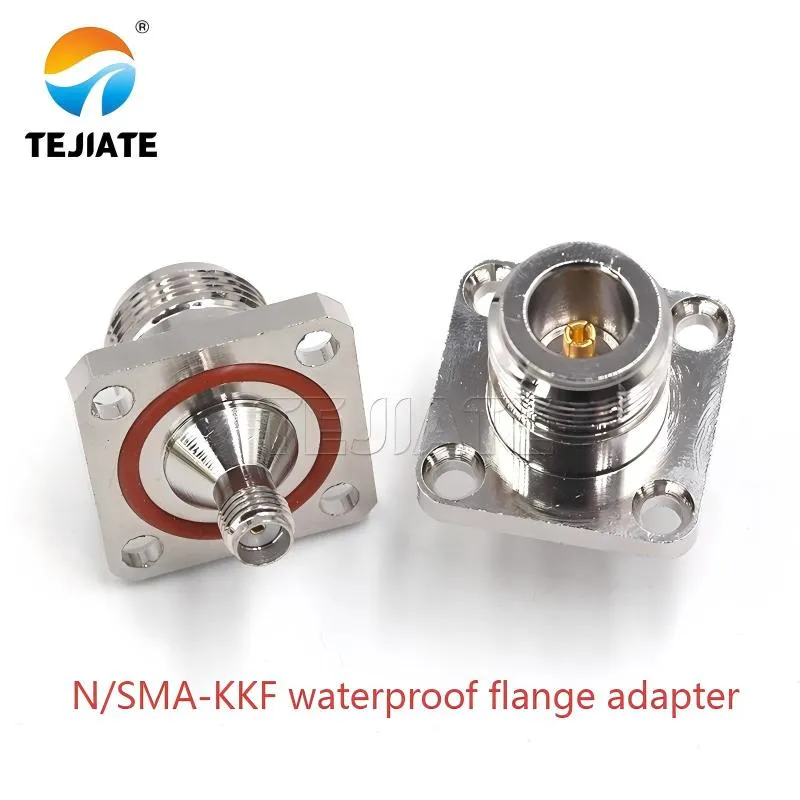
This figure depicts a specific flange-style waterproof adapter (Model N/SMA-KKF). The document context emphasizes its N Female to SMA Female polarity and specifically points out its red silicone O-ring, which is crucial for sealing against rain or dust when installed through cabinet walls or in outdoor gear. This figure is a key physical reference in the discussion of adapter environmental sealing.
- N male → external threads, visible center pin, dielectric pushed back.
- N female → internal threads with the dielectric facing you.
For instance, TEJTE’s N/SMA-KKF waterproof flange adapter (Part No. 40420) mates an N female bulkhead with an SMA female. It’s rated 50 Ω, works from DC to 6 GHz, and maintains VSWR ≤ 1.2. You’ll also notice the red O-ring—an important detail if you’re installing it through a cabinet wall or in outdoor gear where sealing against rain or dust really matters.
SMA male/female vs N male/female: thread, pin and dielectric tells
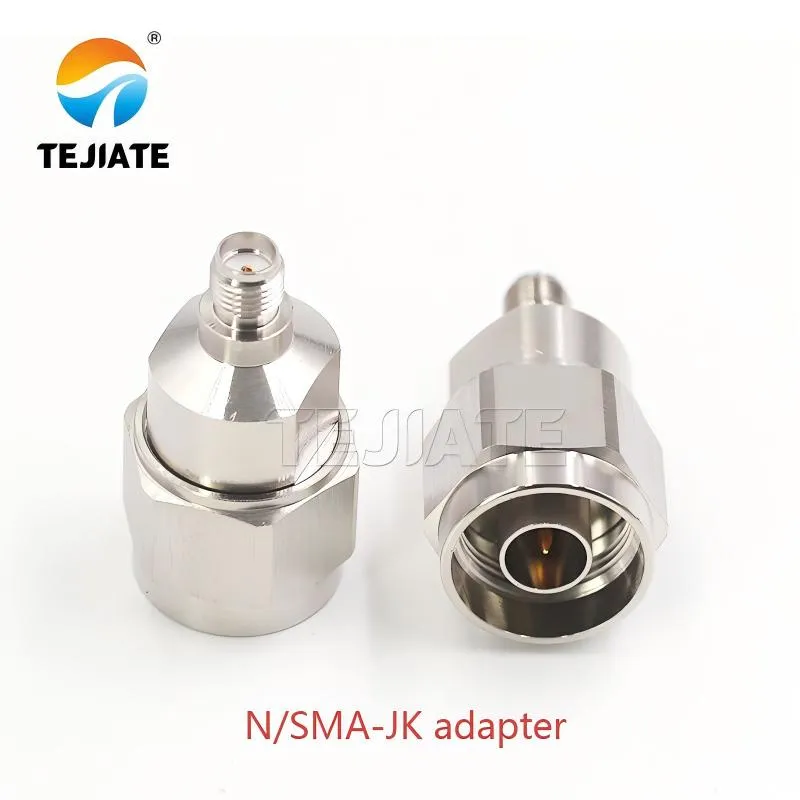
This figure focuses on the adapter's interface details, clearly showing the recessed socket on the SMA female end and the protruding center pin on the N male end. The document uses this figure to illustrate how a quick "pin and thread" inspection can confirm connector gender, a fundamental and effective method to avoid selection errors. The depicted adapter is commonly used to interface lightweight SMA jumper cables with heavier outdoor-grade N connectors.
Avoid the common trap: antenna labeling vs device labeling mismatch
Datasheets and product boxes don’t always tell the full truth. Outdoor antennas, for example, are usually equipped with an N female port, but some suppliers just label them “N-type.” When your indoor device carries an SMA male jack, the actual adapter you need is an N male to SMA female.
That’s where TEJTE’s N/SMA-K flange adapter (Part No. 08764) comes in. Built with brass and designed for 500 mating cycles, it’s a reliable choice for bridging antennas and routers.
Should you choose SMA male to N female or N male to SMA female?
Indoor AP/instrument vs outdoor antenna scenarios mapped to ends
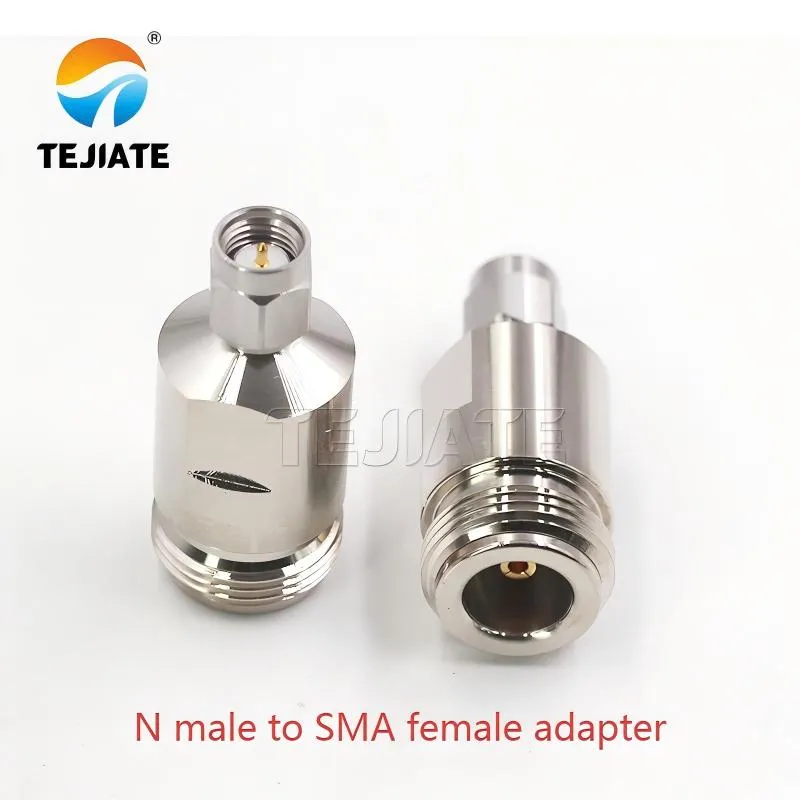
This figure shows a specific adapter combination: N Male to SMA Female. The document references this figure when discussing "indoor AP/instrument vs outdoor antenna scenarios," noting that this adapter is needed when indoor instruments or access points with SMA female jacks require connection to thicker N-type cables. It exemplifies the typical design approach of using the robust N-type connection outdoors while keeping the lighter SMA interface safely inside the equipment.
Many lab instruments and indoor access points come with SMA female jacks on the chassis. To connect these to a thicker N-type cable, you’ll need an SMA male to N female adapter. A practical option here is TEJTE’s N/SMA-JJ inline adapter (Part No. 51040). Rated 50 Ω from DC to 18 GHz and tested for more than 500 mating cycles, it’s built for repetitive use on test benches. Engineers like it because they can swap antennas or cables multiple times without worrying about worn threads or rising VSWR.
By contrast, outdoor antennas are almost always terminated with N female connectors. If your device has an SMA male port, the matching part is an N male to SMA female adapter. This arrangement keeps the robust N-type connection outdoors, where it’s better suited to handle weather and mechanical stress, while the lighter SMA interface stays safely inside the equipment. That balance matters more than most people realize—using the wrong gender pairing often leads to cracked ports or unreliable links.
Field tip: before climbing a tower or mast, double-check both ends of the cable and device. It’s far easier to confirm on the ground than to discover you brought the wrong adapter halfway up.
When a barrel adapter beats a short adapter cable, and why
Inline “barrel” adapters—like TEJTE’s N/SMA-JJ (Part No. 51044)—shine in test environments. They minimize interfaces, keep the signal path short, and add almost no insertion loss. If you’re setting up a rack with plenty of clearance, this is often the cleaner solution.
But the story changes outdoors. A rigid barrel can place a lot of strain on delicate SMA ports when heavy coax hangs off them. That’s why many installers favor a short SMA male to N male adapter cable made with RG-58 or LMR-240. The small amount of flexibility it provides can be the difference between a stable long-term install and a cracked PCB solder joint.
From real-world practice: most field kits include both. The barrel adapter is perfect for lab measurements or quick temporary setups, while the short jumper is the go-to for rooftop installs or mobile gear that moves and vibrates.
Will a right-angle or bulkhead style solve your mechanical constraints?
Strain relief, panel clearance, and torque access in tight enclosures
When you’re routing through a chassis wall, a bulkhead adapter can make life much easier. TEJTE’s N/SMA-KKF waterproof flange adapter (Part No. 40420) is a good example. It comes with four mounting holes and a silicone O-ring, providing a secure mechanical fit and IP-rated sealing. With an operating range from –45 °C to +125 °C and insulation resistance up to 1000 V, it’s designed for tough telecom cabinets and outdoor panels.
In contrast, rack systems often present a different issue—limited clearance behind the port. Here a right-angle N male to SMA female adapter can save the day. It redirects the coax, avoids sharp bends, and keeps torque access practical. The right-angle design reduces stress on the PCB or connector body, especially when equipment is pushed tight against a wall or stacked in dense racks.
Rack gear vs mast mount: pick straight vs right-angle with examples

This figure appears at the beginning of the document, aiming to quickly show readers the main types of adapters they might encounter when interfacing SMA and N connectors (e.g., N Male to SMA Male, SMA to N Female). It establishes a basic visual understanding, setting the stage for the subsequent detailed discussion on the application scenarios of each combination and how to avoid selection errors.
On a lab bench or in rack-mounted analyzers, straight SMA-to-N adapters are usually the right choice. For example, TEJTE’s N/SMA-KJ inline adapter (Part No. 51045) supports DC–18 GHz operation with a VSWR of 1.2:1. That level of performance keeps test results accurate and repeatable, which is exactly what you want during calibration or certification work.
Outdoors, the calculus changes. Mast-mounted antennas benefit from right-angle designs because they naturally direct coax downward, preventing rainwater from tracking into the enclosure. This also keeps stress off the antenna’s N-type threads, which can loosen if cables hang straight out. So the rule of thumb is simple:
- Straight adapters → best for lab precision and measurement integrity.
- Right-angle or bulkhead adapters → better for outdoor survival and tight installations where sealing or clearance is a must.
How do you weatherproof SMA to N transitions for IP67 installs?
O-ring position, thread engagement and torque sequence on N-female
A good weatherproof connection starts with the O-ring. TEJTE’s N/SMA-KKF waterproof flange connector (Part No. 40420) is designed with a red silicone O-ring that compresses when the N male is torqued down. For a reliable seal, the threads must be engaged by at least one major diameter—about 4.5 mm for N connectors and around 2 mm for SMA. Anything less, and you risk both mechanical looseness and moisture entry.
Torqueing matters too. Always hand-tighten first, then apply a wrench. Typical torque for an N-type is 1.35–1.5 Nm, while SMA sits lower at 0.56–0.79 Nm. Over-tighten and you risk cracking the PTFE dielectric; under-tighten and micro-gaps remain, perfect channels for moisture.
Coax sealants, boots and drip loops that survive UV and rain
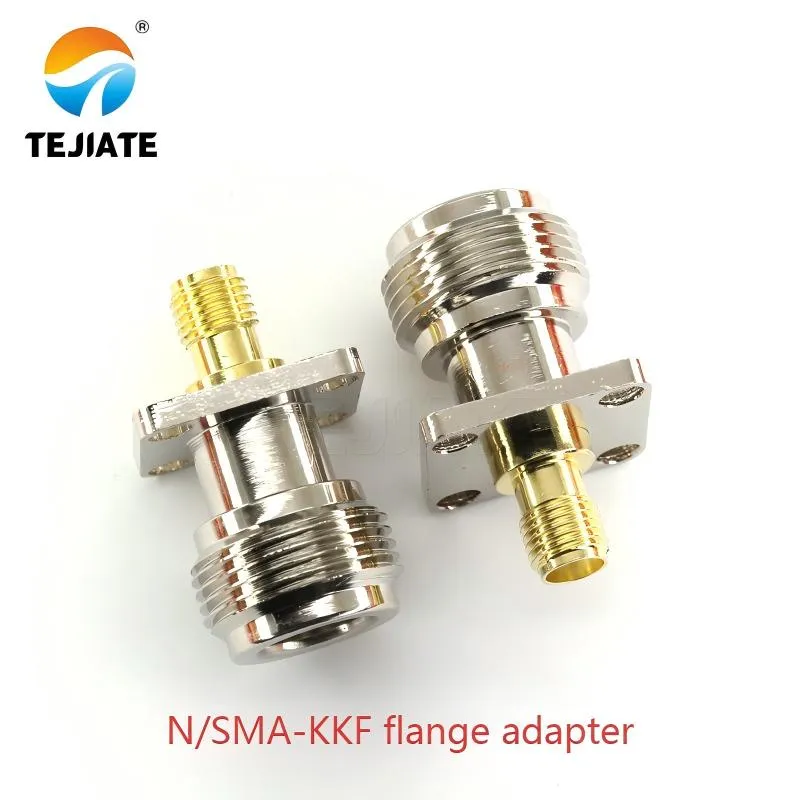
This figure again shows the N/SMA-KKF waterproof flange adapter, potentially focusing on its installation method or sealing characteristics. The document likely references this figure when discussing "weatherproofing," emphasizing how its four mounting holes and O-ring design provide reliable IP-rated sealing for outdoor telecom cabinets or wireless base stations, ensuring long-term connection stability in harsh environments.
Even with O-rings in place, smart installers add a second line of defense. Self-amalgamating tape wrapped around an N female to SMA male adapter provides a watertight barrier. A UV-rated rubber boot on top prevents sunlight from degrading the tape. Finally, a drip loop—letting the coax dip below the entry point—keeps rain from running straight into your cabinet.
For longer deployments, many engineers double up: use a bulkhead adapter such as TEJTE’s N/SMA-K flange adapter (Part No. 08764), then seal with tape and boots. TEJTE also shares more best practices in its bulkhead connector IP67 sealing guide, a useful reference if you’re setting up outdoor telecom cabinets or wireless base stations.
Can you keep 50-ohm match and low loss across the adapter chain?
VSWR budget: how many adapters before your link degrades
A single high-quality SMA to N type adapter—like TEJTE’s N/SMA-JJ inline adapter (Part No. 51040)—is typically rated at VSWR ≤1.2:1 all the way up to 18 GHz. That translates to an insertion loss of less than 0.1 dB, essentially negligible for most systems. But if you start chaining three or four adapters together, the mismatch accumulates.
The rule of thumb many RF engineers use: keep system VSWR under 1.5:1. That usually means no more than two adapters in series. Beyond that, reflections start cutting into your fade margin, especially in weak-signal or long-distance links. On a spectrum analyzer, you’ll see the return loss curve rise; in the field, you’ll notice dropped throughput or unexplained instability.
Prefer fewer interfaces: adapter vs re-terminate pigtail decision
Every mated pair is a potential point of failure. Instead of chaining SMA→N, then N→SMA, then SMA→N again, it’s usually smarter to order a short custom jumper. For instance, an SMA male to N male cable assembly made with RG-58 or LMR-240 keeps loss low and removes unnecessary interfaces.
TEJTE discusses this approach in its U.FL to SMA pigtail guide. The principle is the same: fewer transitions equal fewer problems. Less mismatch, less mechanical stress, and fewer opportunities for water ingress in outdoor environments.
From a field engineer’s point of view, investing in the right pigtail from the start is cheaper than sending a technician back later to troubleshoot why a rooftop link lost 3 dB of margin after six months.
Do you actually need RP-SMA to N instead of SMA to N?
Quick polarity check before ordering; common Wi-Fi patterns
The fastest way to confirm polarity is by looking at the pin.
- RP-SMA male looks like an SMA female, with internal threads—but it has a center pin.
- RP-SMA female looks like an SMA male, with external threads—but it has a socket instead of a pin.
Most consumer Wi-Fi routers come with RP-SMA female jacks. If you’re attaching them to an outdoor N female antenna, the correct choice is an RP-SMA male to N female adapter. Skipping this check often leads to frustration in the field when connectors refuse to mate, even though the threads appear correct.
TEJTE breaks down these polarity pitfalls in detail in its RP-SMA connector polarity guide. Reading it before bulk orders is a smart move, especially if your project involves WLAN deployments or consumer-grade access points.
Installer tip: don’t rely on memory when ordering; always do a quick visual check. Spotting the pin or socket takes just a second and prevents days of wasted lead time.
Safe fallbacks: RP-SMA to N adapter sets for field techs
Experienced technicians rarely head out without backup. Carrying a set of RP-SMA to N adapters alongside standard SMA to N ensures you’re covered no matter what equipment shows up on-site. For example:
- RP-SMA female to N male → bridges consumer APs to rugged outdoor antennas.
- RP-SMA male to N female → connects Wi-Fi gear with outdoor N female ports.
Having both in your kit eliminates guesswork and saves you from scrambling for parts halfway up a mast. It’s a small investment compared to the cost of downtime or repeat site visits.
Order in one pass: which SMA to N adapter matches your use case?
SMA to N Adapter Selection Matrix
| Device Port | Antenna Port | Form | Environment | Thread Engagement Rule | Loss Class | Suggested TEJTE P/N |
|---|---|---|---|---|---|---|
| SMA-M | N-F | Inline | Indoor | ≥2 mm | Single adapter | N/SMA-J, Part No. 51040 |
| N-M | SMA-F | Right-angle | Outdoor IP67 | ≥4.5 mm | Single adapter | N/SMA-K, Part No. 08764 |
| SMA-M | N-F | Bulkhead | Outdoor IP67 | ≥2 mm | Single adapter | N/SMA-KKF waterproof, Part No. 40420 |
| RP-SMA-M | N-F | Inline | Indoor | ≥2 mm | Single adapter | see RP-SMA guide |
| N-F | SMA-M | Short cable (RG-58 / LMR-240) | Outdoor IP67 | ≥4.5 mm | Short cable | see U.FL to SMA pigtail guide |
| N-M | SMA-M | Inline | Indoor | ≥4.5 mm | Chain (≤2) | N/SMA-KJ, Part No. 51045 |
Decision prompts: “Device N-M → Antenna SMA-F = pick …”
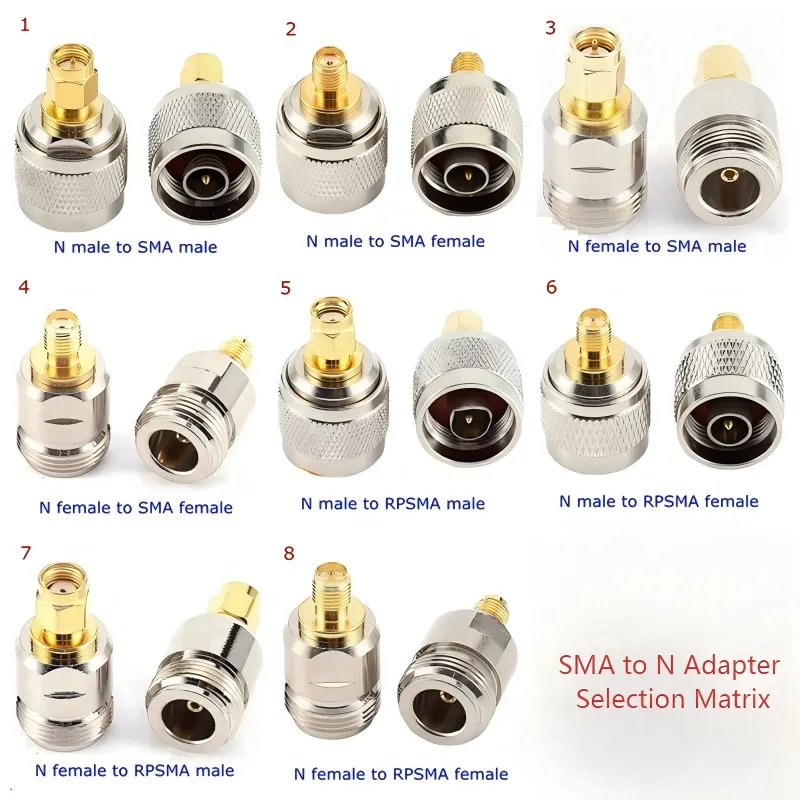
This figure is a central tool in the document. It presents, in the form of a comprehensive matrix or chart, a systematic mapping of various device port types (different genders of SMA, N, RP-SMA) to antenna port types, suggesting corresponding adapter models or solutions. It is designed to help users quickly and accurately select the correct adapter based on their specific equipment interfaces in one pass, avoiding tedious searches and potential selection errors.
- Device has N male, antenna has SMA female → go with an N male to SMA female adapter.
- Device has SMA male, antenna has N female → you’ll need an SMA male to N female adapter.
- Router has RP-SMA female jack, outdoor antenna is N female → select an RP-SMA male to N female adapter.
Install it right: how do you torque and seal the connection?
Wrench sizes, torque targets, and re-torque intervals
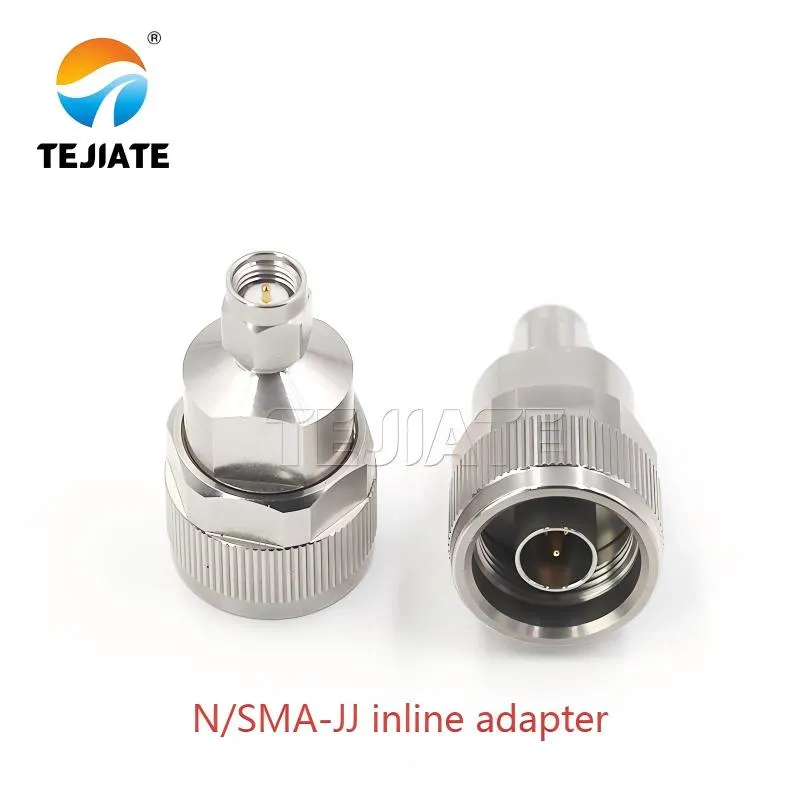
This figure appears when the document discusses "wrench sizes, torque targets, and re-torque intervals." By showing the adapter with the appropriate wrench, it visually emphasizes the importance of using the correct installation tools and adhering to torque specifications. The document notes that the long-term reliability of even high-quality adapters like the N/SMA-JJ (rated for over 500 matings) depends on applying the correct torque during installation.
On SMA connectors, the correct tool is a 5/16″ wrench, and torque should stay within 0.56–0.79 Nm (5–7 in-lb). For N-type connectors, use a 3/4″ wrench and tighten to 1.35–1.5 Nm (12–14 in-lb). TEJTE’s N/SMA-JJ inline adapter (Part No. 51044) is specified for more than 500 matings, but those numbers only hold if torque is kept within range.
Outdoor setups deserve special attention. Wind vibration and temperature cycling can gradually loosen fittings. That’s why many field technicians re-check torque once a year on mast-mounted or rooftop equipment. TEJTE shares more of these best practices in its bulkhead IP67 mounting guide.
Acceptance criteria: no wobble, VSWR < X, insulation intact
Once tightened, check three things before calling the job complete:
- No wobble at the mated interface. If the connector shifts under pressure, redo the torque.
- VSWR remains below 1.2:1 across the intended band. For example, TEJTE’s N/SMA-KKF waterproof adapter (Part No. 40420) holds this spec from DC to 6 GHz.
- Insulation and dielectric are intact. No cracks, chips, or moisture should be visible.
Meeting these simple acceptance criteria ensures your SMA to N adapter performs at its rated spec—whether it’s installed on a lab analyzer or a weather-exposed antenna mast.
FAQs
Which should I buy—SMA male to N female or N male to SMA female—for an outdoor antenna?
Outdoor antennas almost always have N female ports, so the correct choice is an N male to SMA female adapter, such as TEJTE’s N/SMA-K (Part No. 08764).
Will a right-angle SMA to N adapter affect loss or VSWR compared with straight adapters?
Electrically, the difference is minimal. Mechanically, right-angles can relieve stress in tight racks. More on this trade-off is covered in the bulkhead vs right-angle guide.
When is a short SMA-to-N adapter cable better than an inline barrel?
Whenever vibration or heavy coax is involved—like on rooftops—a short jumper is safer. TEJTE explains this in its U.FL to SMA pigtail guide.
How do I make an SMA to N junction weatherproof to IP67 while keeping serviceable?
Use an adapter with an O-ring seal (e.g., Part No. 40420), add self-sealing tape, and form a drip loop in the coax.
Do I need RP-SMA to N instead of SMA to N for Wi-Fi gear, and how can I confirm polarity fast?
Most routers use RP-SMA female jacks. If that’s the case, you’ll need an RP-SMA male to N female adapter. See TEJTE’s RP-SMA polarity guide for a quick check method.
What torque should I apply on N-type and SMA interfaces to avoid damage or loosening?
SMA requires 0.56–0.79 Nm, while N-type needs 1.35–1.5 Nm. Staying within these limits prevents dielectric crush and long-term loosening.
How many adapters in series are too many before link budget becomes a problem?
Two adapters won’t hurt. Once you chain three or more, VSWR often exceeds 1.5:1. At that point, consider a custom jumper instead.
Bonfon Office Building, Longgang District, Shenzhen City, Guangdong Province, China

A China-based OEM/ODM RF communications supplier
Table of Contents
Owning your OEM/ODM/Private Label for Electronic Devices andComponents is now easier than ever.
